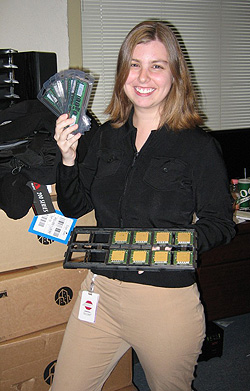Silicon Valley is Broken. Should We Even Bother to Fix It?
![]() There has been a lot of talk about bringing Silicon Valley to other parts of the country–or world. About what makes Silicon Valley unique, and how to replicate it.
There has been a lot of talk about bringing Silicon Valley to other parts of the country–or world. About what makes Silicon Valley unique, and how to replicate it.
As someone who lived in the Valley for 10 years and created a successful technology company there, and who now lives in a decidedly less-tech-heavy area (San Diego), I have a unique perspective: I don’t want Silicon Valley to come to San Diego. In fact, if it did, I’d leave here just like I left the Valley.
A conversation I had recently with an entrepreneur who moved from San Diego to the Valley reminded me of everything that is broken with Silicon Valley. I began by asking him why he’d moved his company to the Valley–I’m always curious about why companies choose to move.
“So, why did you move to the Valley?”
He said the access to connections–other people who could potentially invest in his company–was unprecedented in the Valley. (Later on in the conversation, he admitted that he hadn’t gotten anyone to actually write him a check yet. “But they will,” he promised.)
He proceeded to name-drop several angel investors he’d had meetings with–the same names you hear consistently on TechCrunch, Venture Beat, and other sites commonly read by tech entrepreneurs.
Delving deeper, I asked him about his business strategy. “We’re a consumer-driven Web 2.0 startup,” he said. “We’re like a [name of a well-known, hot startup] for [niche market.]”
“Okay,” I replied. “What’s your lead generation strategy?”
“Lead generation?” he asked me.
“Yes,” I said. “How do you plan to get registered users for your site?”
“Oh,” he replied. “Well, we just started. But once we get some press, that should generate enough buzz that people will come to our site.”
I asked him about hiring talent. I’ve seen several Silicon Valley companies come down here to try to recruit great developers and bring them up to the Valley. “Yeah, San Diego doesn’t have any really high-level developers. You find much better talent in the Valley,” he said.
“Really?” I said. “I’ve hired a lot of people in the Valley. I’ve always found it hard to find good people. They’re usually inundated with startup offers.”
“Well, yes,” he said in a that’s-obvious tone of voice. “I mean, you have to figure out what they want. And you have to pay well.” Before I could ask, he said “$150K for a good, high-level developer–someone you’d pull from Facebook or Google. But we’ll find people. We want people who are passionate about [our niche market], you know.”
I was surprised. “$150K?” I asked. “But that’s pretty much all of your funding for just one or two developers if you go for an angel round.”
“Well, our goal would be to have them work for less and take some equity in the company,” he replied.
I had to ask: “What language are you programming your site in that you can’t find high-level developers?” And he replied, “PHP.”
Angry
At the end of our conversation, I was surprisingly angry. I don’t get angry easily, and I took some time alone to carefully sort through my emotions and understand why I was feeling the way I felt.
Finally, it came to me. This conversation was a microcosm of the reason I left the Valley. No doubt, this guy had a good-looking website, and two co-founders who had signed on to the idea. That part was great.
The part I hated was the “game” he and so many others are caught up in. It’s the merry-go-round of “Let’s find funding first and then get tons of press (when we get funding), and then the user problem will take care of itself.”
This person I talked to was just one of thousands of people caught up in that mentality. My point with this story isn’t to slam him or his site, which is why I’ve anonymized the conversation. It’s to point out the ridiculous goal misalignment in Silicon Valley–funding over revenue; short-term growth over long-term business strategy.
The truth about most Silicon Valley startups
A few years ago, when I was still living in Silicon Valley, I attended the Teens in Tech conference in San Francisco. There, one of my old friends and customers spoke. I had first met him years before when he signed up for a web hosting account at my company. He then moved to San Francisco, and we’d become friends since.
He said something during that presentation to a roomful of teenagers that I’ll never forget. “When I moved to Silicon Valley, I added everyone I met on Facebook,” he said. “And I kept track of them. Of all of the hundreds of people I added there, only one of them ever sold a company for more than a million dollars.”
I looked up, shocked.
That person was me.

Taken in November 2005, this shows me
holding a pile of Xeon processors and RAM
for new servers we were building. Behind me
is about $50,000 of Cisco routers in boxes. I didn’t build the typical Silicon Valley company. I started my company with basically nothing. I built servers from parts, wrote my own shopping cart and merchant account integration in PHP, and designed our website myself. A little over a year into it, my dad gave me a small inheritance from my grandmother’s passing. I debt-financed the company from there, taking an SBA loan, maxing out my credit cards, and stretching terms with our vendors dangerously far.
The first time I pitched investors, one of the people I invited–who I thought would invest in my company–attended the presentation falling-down drunk and proceeded to heckle me from the front row with two of his friends. My company never signed on a single investor.
I consulted for more than two years of running my business to pay my bills. I struggled to pay my own bills. Once, I went to a local store and sold all my DVDs (which I had bought years earlier while still in college) so I could afford food for the week. Another time, when a client didn’t pay on time due to his own cash flow issues, I came home to find a 7-day “pay or get out” notice taped on my apartment door. (Fortunately, the client paid a few days later.)
But I made it. It was one of the hardest things I’ve ever done. I made mistake after mistake. But somehow, every time it seemed hopeless, my inner drive would kick in and I’d fight to keep my company alive. And keep it alive I did, right up to the point where I sold it for $1.1 million in 2007.
That’s what I don’t see in many of these Web 2.0 Valley entrepreneurs. They’re so focused on getting funding that they forget the bigger picture: Building a business is about working your ass off until you feel like you’re going to collapse and then working some more. It’s about getting customers like your life depends on it. (Which, let’s be honest: sometimes it does.) It’s about fighting tooth and nail to succeed.
We’re in another investment bubble right now. With traditional savings accounts and bonds paying next to nothing for the foreseeable future, money is pouring in to venture capital. But Silicon Valley, you can have the “Web 2.0 consumer” startups. I’ll take the fighters. And you know what? Most of the fighters don’t need venture capital. Those of us who are 100% focused on profitability and customers–we don’t need you.
That has to be scary for some of the VC’s out there. And it’s why I relish no longer living in the Valley. No longer do I have to compete for attention with those who take funding round after funding round and assume that “PR” will get them customers. Instead, I can quietly build another multi-million dollar business with no investors whatsoever…and take great joy doing it.
Grow another Silicon Valley? Bring Silicon Valley to other cities? No thanks. Let’s focus on building sustainable, profitable businesses instead.
Recommended Reading:
- The Failure Manifesto. Ever had a day where you just wanted to lock yourself away in your bedroom and cry? Read this.
- The End of An Era. Want to know more about my 10 years in Silicon Valley? Read this post. It includes full details of some harrowing experiences I had never before shared publicly. (Robert Scoble’s favorite post on erica.biz.)
- I’m Not Setting Goals for 2011. Here’s Why: Are goals really a good thing–all the time? I say no. The discussion continues with 50+ reader comments arguing both sides.


